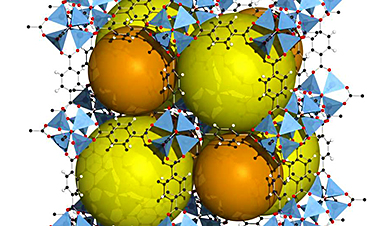The 2025 Nobel Prize in chemistry was awarded to Richard Robson, Susumu Kitagawa and Omar Yaghi on Oct. 8, 2025, for the development of metal-organic frameworks, or MOFs, which are tunable crystal structures with extremely high porosity. These are a class of materials that have truly changed the way scientists design and think about matter, inspiring progress in various applications.
I’m a MOF scientist and for many of us in the field, this recognition feels both historic and deeply personal. MOFs are not just elegant crystals you’d admire under a microscope; they’re an entire universe of structures, each like a miniature city of tunnels and rooms waiting to be filled. They’ve been my scientific home since I first stepped into research, and they still feel a little bit like magic to me.
So, what exactly are MOFs?
Metal-organic frameworks are like crystalline scaffolds built from two ingredients: metals that act like connective joints and organic—that is, carbon-based—molecules that behave as bridges to link those joints in a repeating pattern. The result is a highly ordered, porous framework—a kind of molecular architecture that’s both sturdy and full of empty space.
These frameworks are so porous, like sponges with tiny voids, that it’s almost impossible to picture them. One gram of a MOF has so many pores that it can expose as much internal surface area as a soccer field. It’s astonishing that a handful of powder could hide an entire landscape of surface within it.
That enormous surface area is one of the unique things that make MOFs so powerful, and it comes from the nanoscale pores—tiny molecular rooms that can trap, separate, transform or transport gases, ions and other molecules. In a way, MOFs are like molecular hotels with countless doors, each programmed to admit only certain guests.
Why scientists love them
What fascinates me most about metal-organic frameworks is their limitless design space. Just by glancing at the periodic table, every metal could, in principle, serve as a cornerstone, and countless organic molecules can act as bridges connecting them. Even using the same combination can produce entirely different architectures.
So far, scientists have synthesized more than 90,000 MOFs, and computational chemists have predicted hundreds of thousands more. Few material families offer this much versatility.
I like to think of MOFs as puzzles or Lego sets, but on the atomic scale. You can replace a single piece, or change its color or shape, and end up with a material that behaves completely differently.
Add a new “decoration”—what chemists call a functional group—and the framework suddenly recognizes a new molecule. Stretch the organic bridges, and the same architecture inflates like a balloon, giving what we call isoreticular MOFs. These have the same structure, but bigger pores. In short, MOFs can come in almost every imaginable shape, size and texture.
Beyond their scientific elegance, MOFs are incredibly promising for real-world technologies. Different structures and functionalities lead to different properties and, therefore, different uses.
Some MOFs act as molecular sieves, selectively capturing carbon dioxide from industrial exhaust or even directly from air. Others clean polluted water by removing heavy metals, dyes or “forever chemicals.”
Certain MOFs can also carry drugs or imaging agents inside the body for medical applications. In the energy world, they function as electrodes or electrolytes that make batteries safer and more efficient. And many serve as catalysts, accelerating chemical reactions that transform one molecule into another.
When I began my Ph.D., my senior colleagues warned me that MOFs might be too delicate—beautiful crystals that would crumble at the first hint of air or moisture. And indeed, some of the early frameworks were fragile curiosities, admired more for their elegance than their endurance. But that perception has changed dramatically.
Many MOFs are now remarkably robust. The material I first worked on was a titanium-based metal-organic framework named MIL-125. It was first reported by Gérard Férey, one of the foundational figures in the MOF and porous framework community who sadly died in 2017. MIL-125 was not only stable, it was practically indestructible in my lab. After synthesizing two grams of it, I stored it on my bench in an open vial and used that same batch for every catalytic experiment throughout my Ph.D. No glovebox, no desiccator—just a jar of yellow powder sitting happily on my bench.
That experience taught me something important: While stability can be a legitimate concern, MOFs have grown up. Thanks to smart chemistry, we have materials that can withstand water, heat and repeated use. Since their foundation, researchers around the world have introduced new properties to these materials—from electrical conductivity to light responsiveness—and, crucially, made major progress in scaling up MOF synthesis for industrial applications.
Scaling is the key step in bridging the gap between fundamental discovery and large-scale deployment. Researchers are no longer content with studying MOFs in milligrams—we’re often planning for grams, kilograms and beyond.
Some startups are turning these advances into real technologies—from storing gases more safely, to pulling clean water straight from desert air, to building more energy-efficient air conditioners. What once felt like science fiction—powders that breathe, trap and transform molecules—is now science fact.
Despite these advances, researchers will need to continue improving the stability and scalability of MOFs to fully realize these materials’ potential in the real world.
A Nobel moment that honors creativity
The 2025 Nobel Prize in chemistry goes beyond honoring three remarkable scientists—it celebrates an entire community: a generation of chemists and engineers who transformed a single idea into a thriving field. The pioneering visions of Richard Robson, Susumu Kitagawa and Omar Yaghi laid the foundations for a vibrant discipline that has grown to encompass everything from gas storage and catalysis to energy and environmental technologies.
When I attended my first MOF conference as a second-year Ph.D. student, I listened in awe to many of the pioneers of this field, some of whom are now Nobel laureates. Back then, MOFs felt like magical sponges, and that sense of wonder never left me. It led me to continue my research on conductive MOFs: materials that can carry electricity. Now, in my own research group, we study how these frameworks can make batteries safer and more efficient, and how they can capture waste gases and turn them into useful chemicals using sunlight.
For me, this Nobel Prize celebrates more than a discovery, it celebrates a philosophy: Chemistry is creative, we can design and engineer matter with imagination, and sometimes emptiness can be the very essence of a material.
Provided by The Conversation
This article is republished from The Conversation under a Creative Commons license. Read the original article.
News
New skin-permeable polymer delivers insulin without needles
A breakthrough zwitterionic polymer slips through the skin’s toughest barriers, carrying insulin deep into tissue and normalizing blood sugar, offering patients a painless alternative to daily injections. A recent study published in the journal Nature examines [...]
Multifunctional Nanogels: A Breakthrough in Antibacterial Strategies
Antibiotic resistance is a growing concern - from human health to crop survival. A new study successfully uses nanogels to target and almost entirely inhibit the bacteria P. Aeruginosa. Recently published in Angewandte Chemie, the study [...]
Nanoflowers rejuvenate old and damaged human cells by replacing their mitochondria
Biomedical researchers at Texas A&M University may have discovered a way to stop or even reverse the decline of cellular energy production—a finding that could have revolutionary effects across medicine. Dr. Akhilesh K. Gaharwar [...]
The Stunning New Push to Protect the Invisible 99% of Life
Scientists worldwide have joined forces to build the first-ever roadmap for conserving Earth’s vast invisible majority—microbes. Their new IUCN Specialist Group reframes conservation by elevating microbial life to the same urgency as plants and [...]
Scientists Find a Way to Help the Brain Clear Alzheimer’s Plaques Naturally
Scientists have discovered that the brain may have a built-in way to fight Alzheimer’s. By activating a protein called Sox9, researchers were able to switch on star-shaped brain cells known as astrocytes and turn them into [...]
Vision can be rebooted in adults with amblyopia, study suggests
Temporarily anesthetizing the retina briefly reverts the activity of the visual system to that observed in early development and enables growth of responses to the amblyopic eye, new research shows. In the common vision [...]
Ultrasound-activated Nanoparticles Kill Liver Cancer and Activate Immune System
A new ultrasound-guided nanotherapy wipes out liver tumors while training the immune system to keep them from coming back. The study, published in Nano Today, introduces a biodegradable nanoparticle system that combines sonodynamic therapy and cell [...]
Magnetic nanoparticles that successfully navigate complex blood vessels may be ready for clinical trials
Every year, 12 million people worldwide suffer a stroke; many die or are permanently impaired. Currently, drugs are administered to dissolve the thrombus that blocks the blood vessel. These drugs spread throughout the entire [...]
Reviving Exhausted T Cells Sparks Powerful Cancer Tumor Elimination
Scientists have discovered how tumors secretly drain the energy from T cells—the immune system’s main cancer fighters—and how blocking that process can bring them back to life. The team found that cancer cells use [...]
Very low LDL-cholesterol correlates to fewer heart problems after stroke
Brigham and Women's Hospital's TIMI Study Group reports that in patients with prior ischemic stroke, very low achieved LDL-cholesterol correlated with fewer major adverse cardiovascular events and fewer recurrent strokes, without an apparent increase [...]
“Great Unified Microscope” Reveals Hidden Micro and Nano Worlds Inside Living Cells
University of Tokyo researchers have created a powerful new microscope that captures both forward- and back-scattered light at once, letting scientists see everything from large cell structures to tiny nanoscale particles in a single shot. Researchers [...]
Breakthrough Alzheimer’s Drug Has a Hidden Problem
Researchers in Japan found that although the Alzheimer’s drug lecanemab successfully removes amyloid plaques from the brain, it does not restore the brain’s waste-clearing system within the first few months of treatment. The study suggests that [...]
Concerning New Research Reveals Colon Cancer Is Skyrocketing in Adults Under 50
Colorectal cancer is striking younger adults at alarming rates, driven by lifestyle and genetic factors. Colorectal cancer (CRC) develops when abnormal cells grow uncontrollably in the colon or rectum, forming tumors that can eventually [...]
Scientists Discover a Natural, Non-Addictive Way To Block Pain That Could Replace Opioids
Scientists have discovered that the body can naturally dull pain through its own localized “benzodiazepine-like” peptides. A groundbreaking study led by a University of Leeds scientist has unveiled new insights into how the body manages pain, [...]
GLP-1 Drugs Like Ozempic Work, but New Research Reveals a Major Catch
Three new Cochrane reviews find evidence that GLP-1 drugs lead to clinically meaningful weight loss, though industry-funded studies raise concerns. Three new reviews from Cochrane have found that GLP-1 medications can lead to significant [...]
How a Palm-Sized Laser Could Change Medicine and Manufacturing
Researchers have developed an innovative and versatile system designed for a new generation of short-pulse lasers. Lasers that produce extremely short bursts of light are known for their remarkable precision, making them indispensable tools [...]





















